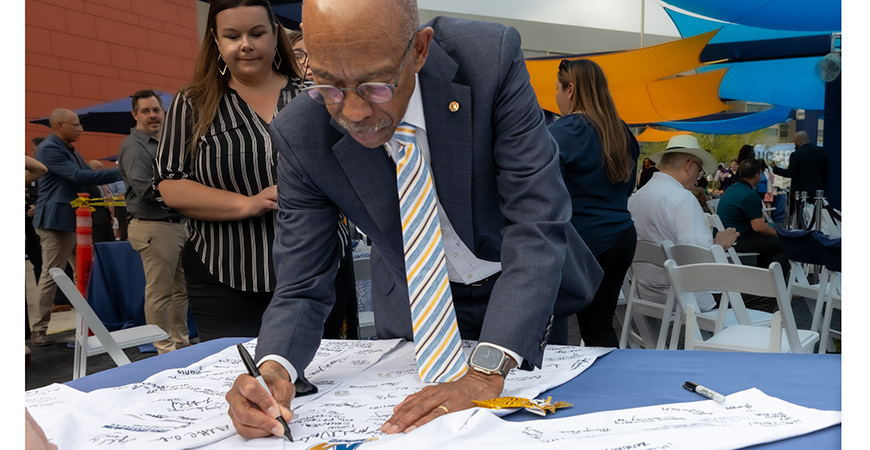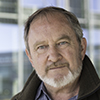
It was a groundbreaking Tuesday night so there were shovels. Many shovels. Full sized, posterized, miniaturized (in a gift box). All to mark a symbolic turning of earth for UC Merced’s Medical Education Center.
The tools also evoke something Dr. Kenny Banh said nearly a year ago. A top administrator at UC San Francisco's Fresno campus, he was talking about San Joaquin Valley PRIME, a program that prepared students from the Valley for a medical career. Training included at least a year in the Bay Area.
“With SJV PRIME, we would take these great students from the Valley and train them in San Francisco," said Banh, assistant dean for undergraduate medical education. "That’s not growing your own garden.”
Related story: Ground Broken for Medical Education Building at UC Merced
The Medical Education Building, scheduled to open in 2026, will host the undergraduate phase of the SJV PRIME+ program, which packages years of undergraduate and medical school training within UC Merced and UCSF Fresno.
“SJV PRIME+ is about taking kids from your backyard and keeping them in your backyard,” Banh said. “It’s called building a community.”
Medical training that stays in the Valley is one SJV PRIME+ tentpole. The other is just as important, if not more so: Students accepted into the program must express an intent to practice medicine in the Valley, thereby improving the quality of health care for a region in dire need of it.
Due to numerous socio-economic and cultural pressures, access to health care is a struggle in the Valley. The region has 130 physicians per 100,000 people, compared to 191 per 100,000 in all of California, according to a 2020 study by the Council on Graduate Medical Education.
The study also looked at what it called Health Professional Shortage Areas. Examples of an HPSA include low-income communities, homeless populations and groups of migrant farmworkers. In California, 28% of the population lives in an HPSA. In the Valley, the number soars to 92%.
Bringing in a place where we can actually grow doctors who can then go out and service their communities … that’s wonderful. This is the beginning of something really special.
“We all are aware of the numbers and how we're underserved, so it's great that this campus that came to the Central Valley and lifted up our educational opportunities is also lifting up our medical opportunities,” said Jack Garamendi, a member of the UC Merced Board of Trustees.
Longtime UC Merced benefactor Fred Ruiz has lived in the Valley since age 9. He has seen the disparities in health care, especially in rural, underserved communities.
“Bringing in a place where we can actually grow doctors who can then go out and service their communities … that’s wonderful,” he said. “This is the beginning of something really special.”
The Medical Education Building will host more than what the university calls its B.S.-to-M.D. program. It also will be home to UC Merced’s Health Sciences Research Institute, its departments of public health and psychological sciences, and other allied health care programs developed with regional community colleges. In short, it’s a full-scale delivery of UC Merced’s keystone commitment to community service.
“A mission of UC Merced is to impact this region economically in terms of health writ large — reducing health disparities, increasing access to care and health professionals,” public health Professor Nancy Burke said. “Also, we have faculty, graduate students and postdocs doing research that addresses the social, political and cultural structures that impact health here. It’s pretty unique.”
Dr. Marisela Rangel-Garcia, a Fresno gastroenterologist and one of the first students in the original SJV PRIME program, has a unique point of view of that mission.
“As a freshman at UC Merced back in 2005, I wasn't sure what I wanted to do but after being influenced by multiple people here, I decided to pursue medicine. I was inspired by patients that I saw as a volunteer at Mercy Medical Center Merced,” Rangel-Garcia said.
“UC Merced has been a huge part of my journey. And now as I return to the Valley, I'm excited to be here to serve patients and excited by what the future holds for the Central Valley with the Medical Education Building.”
The word “seventh” was spoken more than once at the groundbreaking ceremony. It referred to the six medical centers in the UC system. Someday — certainly not any time soon — UC Merced will add to that number, with this building and the programs within signifying a mighty leap in that direction.
“We have 5 million people in the San Joaquin Valley. If we were a state, we’d be the 27th largest in the country, and we’d be the largest without a medical school,” said state Assembly Member Joaquin Arambula. “I spent 10 years on the front lines of health care as an emergency room doctor. I’m looking forward to seeing reinforcements on the horizon.”
As a cloudy dusk fell on Tuesday night’s ceremony and six golden shovels plunged into earth, it was a time to celebrate not just the moment but the months and years and decades to come.
“What we’re doing tonight is setting off what’s going to happen 20, 30, 40, 50 years from now,” said Executive Vice Chancellor and Provost Betsy Dumont, “which is to be a Valley empowered with health care and empowered with the ability to build to take care of itself and take care of other regions of California.”




 Public Information Officer
Public Information Officer

